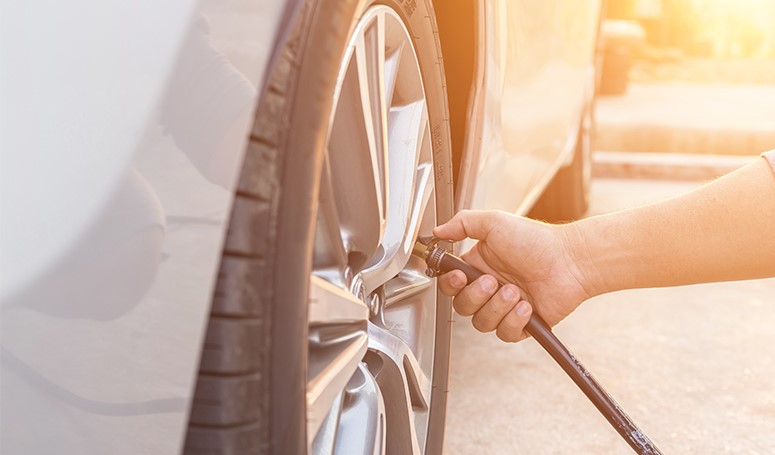16th September, 2022
It’s easily forgotten about sometimes, but you should always remember the importance of checking your vehicle’s tyre pressures, tread depth and general condition on a regular basis. Doing this will improve road safety and could help you save money.
It’s recommended you check your tyre pressure every couple of weeks – especially, ahead of long-distance journeys to ensure you’re not at risk. Not doing so could result in you breaking down, receiving fines or being faced with an unwanted bill at the garage.
Here at One Call Insurance, we want to help keep you safe whilst you’re out on the roads. With that in mind, we’ve pulled together some tips on how to go about checking your tyre pressure and why it’s so important!
Why it’s important to check your tyre pressure:
As mentioned, you should ensure your tyres are in great condition at all times. Doing this will help keep you and other motorists safe as having the wrong tyre pressure or tread depth poses a huge road safety risk to you and other drivers.
Whilst the legal tyre tread limit is 1.6mm, it’s generally advised to change your tyres once the thread gets down to 3mm.
If the police catch you driving with tyres worn below the legal limit, you could be fined £2,500 and given three penalty points per tyre. Meaning, a full set of illegal tyres could cost you a £10,000-fine and, potentially, the loss of your licence.
There are also consequences for not inflating your tyres frequently. For example, unkempt tyre pressures can increase fuel consumption and wear on various components – meaning you could be paying more than you should be if you don’t keep on top of this.
If you’re unsure of the correct tyre pressures for your car, don’t worry! You will find the correct pressures listed in your vehicle handbook.
As we move with the times, manufacturers are doing more to maintain road safety.
Since 2014, all new cars sold in the EU must come with a tyre-pressure monitoring system (TPMS).
A TPMS is an electronic system which detects a drop in air pressure. Whilst most new cars are likely to come fitted with TPMS, it’s not guaranteed. Plus, older vehicles are unlikely to have one.
Not to worry, if you don’t have a TPMS fitted, there are plenty of aftermarket kits which you can purchase. They simply plug into your vehicle and visually or audibly warn you when your tyre pressure gets too low.
How to check your tyre pressure:
Here’s a quick step-by-step guide on how to check your tyre pressure:
It’s easy to check your tyre pressures using a manual or digital tyre pressure gauge – these can easily be bought online. You can also use the equipment provided on petrol station forecourts, although you should bear in mind that there is often a small charge.
Tyre pressure is measured using two units: bar (where 1 bar is the pressure of the Earth’s atmosphere at sea level) and pounds per square inch (shortened to psi).
To check the pressure, simply unscrew the plastic dust cover on the wheel’s tyre air valve and keep it somewhere safe while checking the pressure (always remember to screw it back on when you’re finished!
Place the pressure gauge over the valve, push it in slightly and hold it for a few seconds. A pressure reading should appear on the gauge’s screen.
It’s always worth examining the tyre for anything sharp that may be struck in the tread or unusual bulges in the tread surface and sidewall of the tyre.
If you find anything, get the tyres checked straight away, as damaged tyres can blow out without warning. You can get them checked at a local garage if you’re unsure.
The law requires a minimum tread depth of 1.6mm in a continuous band around the central three quarters of the tyre.
You can check the tyres tread depth with a tyre tread depth gauge, but manufacturers often mould little bars into the tread at a height of 1.6mm.
When the main tread blocks wear down to the height of the little bars, it’s time for a new tyre.
If you have older or more worn tyres, you could use the 20p tyre test by placing a coin in the main grooves of the tyre. If you can’t see the outer rim on the coin, then your tread depth is above the legal minimum. Just remember that this is not always completely accurate.
However, if that outer rim is still visible your tyre tread depth could be too low, and you should get them checked by a professional.
Conduct the 20p tyre test in at least three different places along each tyre, as one part might be more worn than another.
To be extra safe, you should check your air pressure and tread depth at least once a month.
* By clicking this link, you will be redirected to away from our website.
* Please note that the above information has been gathered through secondary research. The information provided is not based on our opinion. You should seek further guidance and information before making an informed decision.
Source: https://www.confused.com/car-insurance/guides/how-to-check-your-tyre-pressure-tread-depth
https://www.rac.co.uk/drive/advice/how-to/checking-tyre-pressure/

